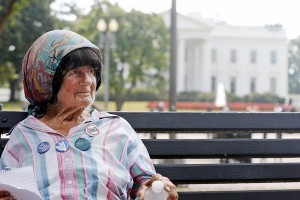The woman outside the White House (said no to nuclear armament & fracking)
>>> From the Obituary of Concepcion Picciotto, Washington Post, January 26, 2016
Concepcion Picciotto, the protester who maintained a peace vigil outside the White House for more than three decades, a demonstration widely considered to be the longest-running act of political protest in U.S. history, died January 25th at a housing facility operated by N Street Village, a nonprofit that supports homeless women in Washington. She was believed to be 80.
She had recently suffered a fall, but the immediate cause of death was not known, said Schroeder Stribling, the shelter’s executive director.
Ms. Picciotto — a Spanish immigrant known to many as “Connie” or “Conchita” — was the primary guardian of the anti-nuclear-proliferation vigil stationed along Pennsylvania Avenue. In a 2013 profile in The Washington Post, Ms. Picciotto said she spent more than 30 years of her life outside the White House “to stop the world from being destroyed.”
Through her presence, she said she hoped to remind others to take whatever action they could, however small, to help end wars and stop violence, particularly against children.
Ms. Picciotto, a diminutive woman perpetually clad in a helmet and headscarf, was a curious and at times controversial figure in Washington. Fellow activists lauded her as a heroine. Critics and even casual passersby, reading her hand-lettered signs, dismissed her as foolish, perhaps unwell. Ms. Picciotto was quick to share elaborate accounts of persecution by the government, which she considered responsible for many of her physical ailments.
Ellen Thomas, a demonstrator who protested alongside Ms. Picciotto for decades, told The Post in 2013 that the truth was somewhere in between. She acknowledged that there were “issues that haven’t been addressed” where Ms. Picciotto’s mental health was concerned but lauded her dedication and stamina.
She met William Thomas, a self-described wanderer, philosopher and peace activist who founded the peace vigil along Pennsylvania Avenue. Ms. Picciotto joined Thomas there in 1981 — since she could not help her own child, she said, she wanted to do what she could to help other children — and the two became a fixture in the park.
They were joined in 1984 by Ellen Benjamin, who soon married Thomas. The budding romance sparked hostility from Ms. Picciotto, who questioned Ellen Thomas’s motives for joining the protest and believed the new woman was after William Thomas’s money.
But despite that perpetual tension, Ellen Thomas told The Post, the trio protested together in the park for 25 years. The group’s grass-roots nuclear disarmament campaign was known as Proposition One, and its crowning achievement came in 1993, when a nuclear disarmament petition circulated by the activists resulted in a ballot initiative passed by District voters.
Eleanor Holmes Norton, the District’s congressional delegate, helped the activists prepare a nuclear disarmament and conversion act, which she has since introduced in nearly a dozen sessions of Congress. The legislation has never reached the floor for a vote. Norton told The Post in 2013 that although the value of the vigil’s presence could not be readily quantified, it has served as an important and ongoing reminder to all who passed by.
“They want to keep the issue of nuclear proliferation and its potential terrible consequences before the public,” Norton said of the protesters. “And they have chosen a prime spot to do it. . . . We won’t ever know what the success is, because it doesn’t have a specific end of the kind we are used to.”
From their rudimentary encampment on the red-brick walkway in Lafayette Square, the protesters demonstrated against wars and military conflicts, survived historic blizzards and scorching heat waves, and endured tense confrontations with passersby and police.
The vigil evolved into a well-recognized feature of the city’s landscape. The makeshift shelter became a regular stop for D.C. tour guides and a topic of discussion in local college classrooms. The vigil and its keepers made a cameo appearance in Michael Moore’s 2004 political documentary film “Fahrenheit 9/11” and starred in another feature-length documentary, “The Oracles of Pennsylvania Avenue” (2011).
When Thomas died in 2009, Ms. Picciotto vowed to continue her protest in his honor. But the vigil’s future was called into question in recent years, as its aging caretaker faced health problems and the possibility of eviction from the home she shared with other activists in Northwest Washington.
After Ms. Picciotto was hit by a cab in 2012 while riding her bicycle, she came to rely heavily on the help of younger activists to maintain the vigil, which could not be left unattended, according to National Park Service rules.
For months, the activists — many of whom lived with Ms. Picciotto at Peace House, a rowhouse owned by Ellen Thomas — took turns guarding the vigil, allowing Ms. Picciotto to scale back her watch to just a few hours each day.
But on two occasions in recent years, activists abandoned their station during overnight shifts, and the shelter and its signs were quickly removed by police. In both instances, the station and its signs were later returned by authorities.
Peace House was sold last year,, and Ms. Picciotto eventually found shelter at N Street Village, within walking distance of her vigil. “I have to be here,” she said of her work. “This is my life.”
See the Washington Post video here.

